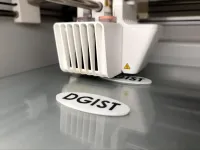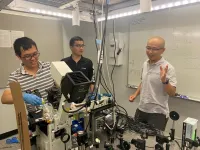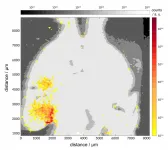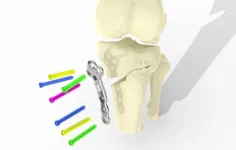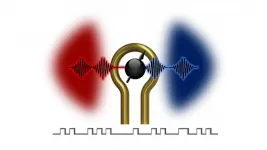(Press-News.org) The treatment of many medical issues like abnormal gait and muscular disorders require an accurate sensing of applied pressure. In this regard, flexible pressure sensors that are simple, lightweight, and low-cost, have garnered considerable attention. These sensors are designed and manufactured through "additive manufacturing," or what is more commonly called "3D printing," using conductive polymer composites as their building blocks.
However, all 3D-printed pressure sensors developed so far are limited to sensing applied forces along a single direction only. This is hardly enough for real world applications, which involve situations where forces can be applied along various angles and directions. Moreover, the electrical resistance of most conductive polymers varies with temperature and must be compensated for accurate pressure sensing.
In a study published in Composites Part B: Engineering, a group of scientists led by Prof. Hoe Joon Kim from Daegu Gyeongbuk Institute of Science and Technology, South Korea, have addressed this issue with a newly designed multi-axis pressure sensor coupled with a temperature-sensing component that overcomes the limitations of conventional sensors. "Our multi-axis pressure sensor successfully captures the readings even when tilted forces are applied. Moreover, the temperature-sensing component can calibrate the resistance shift with temperature changes. In addition, the scalable and low-cost fabrication process is fully compatible with commercial 3D printers," explains Prof. Kim.
Scientists first prepared the printable conductive polymer using multi-walled carbon nanotubes (MWCNTs) and polylactic acid (PLA). Next, they built the sensor body with a commercial elastomer and sensing material with MWCNTs/PLA composite filament using 3D printing. The sensor is based on a bumper structure with a hollow trough beneath and employs three pressure-sensing elements for multi-axis pressure detection and a temperature-sensing element for calibration of resistance. The sensor could successfully calibrate both the magnitude and direction of the applied force by evaluating the response of each pressure-sensing element. This bumper structure, when installed in a 3D-printed flip-flop and a hand gripper, enabled clear distinction between distinct human motions and gripping actions.
The scientists are thrilled about the future prospects of their 3D-printed sensor. "The proposed 3D printing technology has a wide range of applications in energy, biomedicine, and manufacturing. With the incorporation of the proposed sensing elements in robotic grippers and tactile sensors, the detection of multi-directional forces along with temperature could be achieved, heralding the onset of a new age in robotics," comments an excited Prof. Kim.
Indeed, those are some interesting consequences to look forward to!
INFORMATION:
Reference
Authors: Hang-Gyeom Kim1, Sugato Hajra1, Dongik Oh1, Namjung Kim2, Hoe Joon Kim1,*
Title of original paper: Additive manufacturing of high-performance carbon-composites: An integrated multi-axis pressure and temperature monitoring sensor
Journal: Composites Part B: Engineering
DOI: https://doi.org/10.1016/j.compositesb.2021.109079
Affiliations: 1Department of Robotics Engineering, Daegu Gyeongbuk Institute of Science and Technology (DGIST)
2Department of Mechanical Engineering, Gachon University
*Corresponding author's email: joonkim@dgist.ac.kr
About Daegu Gyeongbuk Institute of Science and Technology (DGIST)
Daegu Gyeongbuk Institute of Science and Technology (DGIST) is a well-known and respected research institute located in Daegu, Republic of Korea. Established in 2004 by the Korean Government, the main aim of DGIST is to promote national science and technology, as well as to boost the local economy.
With a vision of "Changing the world through convergence", DGIST has undertaken a wide range of research in various fields of science and technology. DGIST has embraced a multidisciplinary approach to research and undertaken intensive studies in some of today's most vital fields. DGIST also has state-of-the-art-infrastructure to enable cutting-edge research in materials science, robotics, cognitive sciences, and communication engineering.
Website: https://www.dgist.ac.kr/en/html/sub01/010204.html
About the author
Hoe Joon Kim, an assistant professor of Robotics Engineering at DGIST, is fascinated by micro/nanofabrication techniques and the integration of emerging nanomaterials with micro/nanodevices. He earned a PhD degree in Mechanical Engineering from the University of Illinois, USA. He was a post-doctoral researcher at Carnegie Mellon University's Micro and Nano Systems Laboratory in the USA, where he worked on the development of low-power low-noise piezoelectric MEMS resonators for sensing and frequency control applications. His research areas also include piezoelectric MEMS resonators for RF wireless communication, chemical/physical sensing, and environmental monitoring.
CHAMPAIGN, Ill. -- Sharing ideas in an online learning environment has a distinct advantage over sharing personal details in driving learner engagement in massive open online courses, more commonly known as MOOCs, says new research co-written by a University of Illinois Urbana-Champaign expert who studies the intersection of marketing and digital environments.
Online learning engagement can be increased by nearly one-third by simply prompting students to share course ideas in a discussion forum rather than having them share information about their identity or personal motivations for enrolling, said Unnati Narang, a professor of business administration at the Gies College ...
RESEARCH TRIANGLE PARK, N.C. -- Army-funded research identified a new chemistry approach that could remove micropollutants from the environment.
Micropollutants are biological or chemical contaminants that make their way into ground and surface waters in trace quantities.
Using a pioneering imaging technique, Cornell University researchers obtained a high-resolution snapshot of how ligands, molecules that bind to other molecules or metals, interact with the surface of nanoparticles. In doing so, they made an unexpected breakthrough discovery. They determined that by varying the concentration of an individual ligand they could control the shape of the particle it attached too.
This approach could ...
When there is a gas leak in a large building or at an industrial site, human firefighters currently need to go in with gas sensing instruments. Finding the gas leak may take considerable time, while they are risking their lives. Researchers from TU Delft (the Netherlands), University of Barcelona, and Harvard University have now developed the first swarm of tiny - and hence very safe - drones that can autonomously detect and localize gas sources in cluttered indoor environments.
The main challenge the researchers needed to solve was to design the Artificial Intelligence for this complex task that would fit in the tight computational and memory constraints of the tiny drones. They solved this challenge by means of bio-inspired navigation and search strategies. The scientific ...
A new study finds forensics researchers use terms related to ancestry and race in inconsistent ways, and calls for the discipline to adopt a new approach to better account for both the fluidity of populations and how historical events have shaped our skeletal characteristics.
"Forensic anthropology is a science, and we need to use terms consistently," says Ann Ross, corresponding author of the study and a professor of biological sciences at North Carolina State University. "Our study both highlights our discipline's challenges in discussing issues ...
Super-thin carbon molecular sieve (CMS) membranes may not be best for separating industrially important chemical mixtures. However, ensuring the CMS film thickness is just right could enable more energy-efficient purification of chemical products, KAUST researchers have shown.
CMS membranes, as their name suggests, can purify mixtures of liquids or gases by permitting only certain molecules to pass through their subnanometer-sized pores. Currently, the chemical industry mainly uses heat-based processes such as distillation to separate product mixtures, but these processes consume about 10 percent of global energy output. "This situation is highly unsustainable," says Wojciech Ogieglo, a research scientist at KAUST. "We believe that a good ...
The premise of heated tobacco (HT) is simple: tobacco leaf is heated, never burnt, so avoiding many harmful by-products of combustion for the user. The exhaled 'mist' is correctly termed an aerosol, which is almost invisible and far less dense and pungent than the exhaled smoke from combustible cigarettes.
Another advantage of HT is that there are no 'side-stream' emissions to impact air quality (or disturb bystanders - these emissions form part of the ambient smoke that's often known as environmental tobacco smoke (ETS) or 'second-hand' smoke), because unlike a combustible cigarette there is no constantly burning tip. Our previous research suggests that, unlike cigarettes, using our Pulze heated tobacco device causes no negative impact on indoor air quality ...
Researchers have found evidence for an anomalous phase of matter that was predicted to exist in the 1960s. Harnessing its properties could pave the way to new technologies able to share information without energy losses. These results are reported in the journal Science Advances.
While investigating a quantum material, the researchers from the University of Cambridge who led the study observed the presence of unexpectedly fast waves of energy rippling through the material when they exposed it to short and intense laser pulses. They were able to make these observations by using a microscopic speed camera that can track small and very fast movement on a scale that is challenging with many other techniques. This technique probes the material with two light pulses: the first one disturbs it ...
In lab tests, Imperial researchers have created a metal-based molecule that inhibits the build-up of a peptide associated with Alzheimer's disease.
A peptide is a fragment of a protein, and one of the key hallmarks of Alzheimer's disease is the build-up of a specific peptide known as amyloid-β. The team demonstrated that with the aid of ultrasound, their molecule can cross the blood-brain barrier in mice, targeting the part of the brain where the damaging peptide most often accumulates.
Alzheimer's disease is the most common form of dementia, affecting approximately 50 million people worldwide. There is a pressing need to develop drugs ...
Pioneering 'printed metal' procedure to create bespoke treatment for early knee osteoarthritis set to be trialled in the UK following MHRA approval.
World's first 3D printed high tibial osteotomy (HTO) device and procedure developed at University of Bath given approval for UK trials
Bespoke titanium alloy HTO implants that fit perfectly are designed to reduce discomfort for knee osteoarthritis patients
Sophisticated 3D scanning aims to make surgery quicker and safer
New TOKA process could make earlier intervention possible - saving patients decades of pain before surgery becomes viable
Intro
A ...
Many of us swing through gates every day -- points of entry and exit to a space like a garden, park or subway. Electronics have gates too. These control the flow of information from one place to another by means of an electrical signal. Unlike a garden gate, these gates require control of their opening and closing many times faster than the blink of an eye.
Scientists at the U.S. Department of Energy's (DOE) Argonne National Laboratory and the University of Chicago's Pritzker School of Molecular Engineering have devised a unique means of achieving effective gate operation with a form of information processing called electromagnonics. Their pivotal discovery allows real-time control of information transfer between microwave photons and magnons. And it could result in a new generation ...
